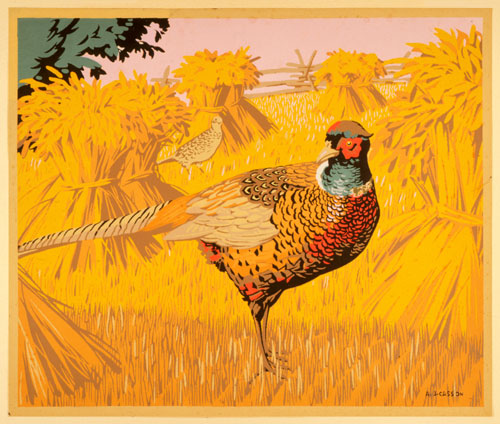Screenprint
Positive
stencils were used for colouring early
woodcuts, and have been used in Europe
and America for commercially printing lettering
from the 19th century. Masking stencils
used in conjunction with a meshed screen
were a Japanese invention several centuries
old when imported into Europe at the end
of the 19th century. The European adaptation
of screenprinting to a commercial technique
for cheap colour printing for packaging
etc. was patented in England in 1907 and
in America in 1915.

Albert
Joseph Casson (1898–1992): "Pheasant
in a Corn field".
American colour screenprint (serigraph) c1930. (215
x 260 mm)
It
was in North America during the Depression
that artists involved with the Federal
Art Project began to experiment with screenprint
aesthetically. It had the advantage of
cheapness through requiring very little
(and unsophisticated) equipment. Americans
adopted the term serigraph (silkscreen
drawing) to distinguish artists’ original
prints in the medium from its commercial
application.
In
screenprint the image is built up by superimposing
layers of different coloured inks. The
ink is transferred to the paper by forcing
it through a fine meshed screen (silk,
cotton or metal) with a wooden and rubber
paddle known onomatopoeically as a squeegee.
At its most primitive cut-out paper shapes
applied to the underside of the mesh block
the transfer of colour in those areas.
A different screen and set of masking stencils
is used for each colour. The mesh can also
be blocked by the artist drawing directly
on the screen with liquid glue. The colours
print with a hard edge and a slight texture
given by the mesh. Early examples have
a literal weightiness from the many superimposed
layers of ink (see the illustration of
the Casson “Pheasant” above and
click for an enlarged detail).

Howard
Hodgkin (Born 1932):
"Indian View C".
Colour screenprint, 1971. (580 x 776 mm)
Artists
did not fully exploit screen printing as
a new technique till the 1960’s,
when it lent itself in different ways to
both the prevailing styles of hard-edge
abstraction and figurative pop-art. |